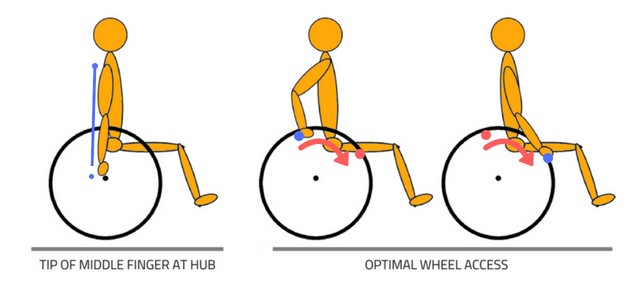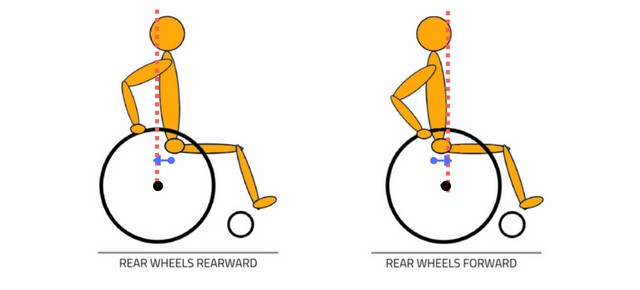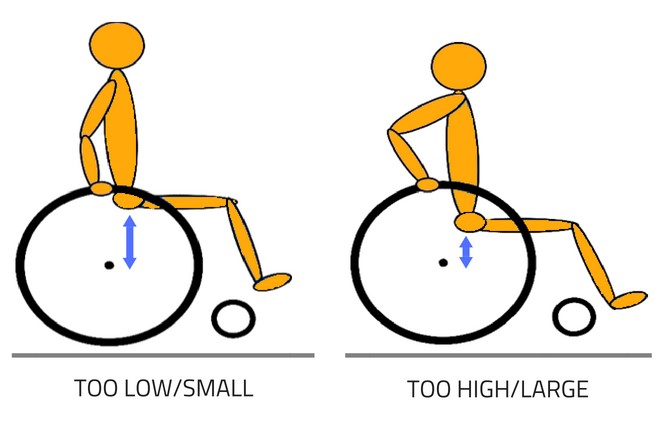Share:
Take it offline!
This Education in Motion resource is also available as a printable PDF.
Download PDF
Are you efficient when propelling your wheelchair? Is propelling your wheelchair painful for you? This may have to do with the position of your rear wheel.
Manual self-propulsion is the kind of mobility used by people with lower extremity disabilities in order to keep having independence and autonomy to complete daily activities.

Users completely rely on their upper extremities for mobility and increase their risk of upper-limb overuse injuries. To reduce the risk of injury, optimal rear wheel position needs to be taken into account.
Optimal rear wheel access
An optimally adjusted wheelchair should allow the user to reach the wheel hub with the tip of the middle finger. This makes the centre of mass to be positioned over the wheel hub, and ensure the elbows to be at around 100-120° angle between the upper arm and forearm when they are on top of the handrim.

Taking into account that this is the optimal elbow angle to avoid possible injuries when self-propelling, rear wheels need to be vertical and horizontally adjusted in order to:
- Allow you to have a comfortable and stable position.
- Maximise function.
- Maximise propulsion efficiency.
- Decrease the risk of repetitive strain injuries.
However, we often find many cases in which the position is not optimal. So what happens when the rear wheel is not in the optimal position?
Rear wheel horizontal position
Has you wheelchair ever tipped backwards? Do you find your wheelchair difficult to manoeuvre? Do you know why these situations happen? The centre of mass or centre of gravity can have a big impact on a chair being too tippy. The centre of gravity can be set for the user by adjusting the rear wheels horizontally forwards or backwards.
The centre of gravity has a direct influence on how the weight is distributed between the rear wheels and the front casters. At the same time, this weight distribution will have an impact in the wheelchair’s performance: rolling resistance and manoeuvrability.
In the case of adjusting the rear wheels backwards:
- The user’s centre of gravity moves forward.
- There is more weight over the front casters, which makes the wheelchair more difficult to manoeuvre and harder to roll.
- Longer wheelchair footprint and turning circle.
- Stability increases significantly.
- The arms make more effort, as the elbow is excessively flexed.
- Risk of upper limb overuse injury increases.
- Inefficient stroke.
In summary, this would be the rear wheel configuration of a wheelchair for more passive users, but very stable.

On the contrary, in the case of adjusting the rear wheels forward:
- The user’s centre of gravity moves rearward
- There is less weight over the casters, requiring less power to propel and manoeuvre it and allowing for a smoother ride
- Smaller wheelchair’s footprint and turning swing
- Stability decreases
- The arms need less effort
- Risk of upper limb overuse injury decreases
- More efficient stroke
In this case, this would be the typical rear wheel configuration of a wheelchair for more active users, but it will be less stable. That’s why the user may need some training to improve their wheelchair skills.
Rear wheel vertical position
Most active wheelchairs allow for vertical adjustability. Positioning rear wheels up or down in relation to the frame of a manual wheelchair will have an effect on seat-to-floor height, orientation in space and rear wheel access.
If your rear wheels are too low or small, it means that you cannot reach the hub. This specific position will have some effects.
- You will have less access to the handrim surface and result in an inefficient stroke.
- You will need more repetitions to cover a certain distance.
- Consequently, you will experience an increase in the stress on the upper limbs muscles.

If your rear wheels are too high or large, it means that your fingertips could be resting beyond the wheel hubs. In this case, you will have the opposite effects:
- Your shoulders will be continuously elevated upwards and elbows excessively bent during propulsion.
- This can cause damage to shoulder muscles: tendinitis, rotator cuff tears and impingement.
- If rear wheels are too big, they can make transferring in or out more difficult, as the seat-to-floor height increases and getting in or out of the seat is more difficult.
As you have seen, each configuration is different in function and purpose. The wheelchair should be adjusted individually to meet each user’s needs safely and functionally.
“Person cannot conform to the chair but the chair must conform to the individual”
RESNA 2012
At Sunrise Medical, we offer a wide range of adjustable manual wheelchairs, so that you can find the right configuration for you and your needs. Remember that it is important that you let yourself guide by a professional in order to conduct an individual assessment and get advice on the right solutions.